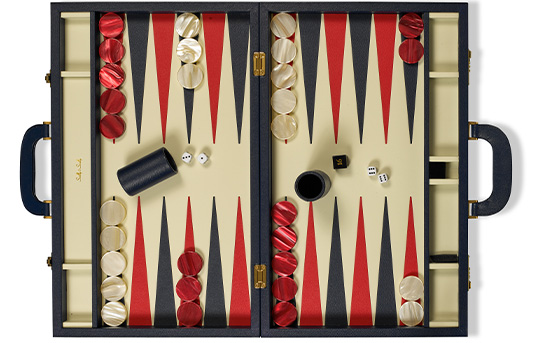Backgammon is one of the oldest known board games in history. The exact origins of the game remain unknown but can roughly be traced back to archaeological discoveries in Mesopotamia. Backgammon is, by simplified means, a dice game and can be seen historically from numerous corners of the world. Dice, historically, were first created from carving human bones, along with many of the original findings of the game. During the 1920s, Sir Leonard Woolley, a British archaeologist, excavated Ur of the Chaldees, the Biblical home of Abraham. While excavating the royal cemetery, he found five-game layouts that hold similarities to the game boards. Made of wood and intricately decorated with shell, bone, lapis lazuli, and more, discoveries such as this continued to pop up all over the world.

How to play:
A two-player game, backgammon consists of twenty-four narrow triangles called points. They alternate in color and group into four quadrants of six, which are a player’s home board and outer board. The outermost point is the twenty-four point and the one point for your opponent. Each player has fifteen checkers and the initial arrangement consists of two on each player’s twenty-four point, five on every thirteen points, three on each eight-point, and five on each six-point. Each player has a pair of dice and a dice cup while a doubling cube is used to keep track of the current state of the game.
The object of the game is to move all of your checkers onto your board and then remove them entirely. To start the game, each player rolls a single die to determine who goes first and the number they will play. The player with the largest number will move their checkers around the board based on the numbers on the dice. After the first roll, the players alternate rolling two dice. Pips, or the number of points rolled, shows the player how far to move his checkers. The checkers are always moved forward to a lower-numbered point.
A bot is a point occupied by a single checker. If an opposing checker lands on a blot, the blot is hit and placed on the bar. Any time a player has one or more checkers on the bar, the goal is to get them onto the opposing home board. If neither of the points rolled is open, the player loses a turn. If a player can enter some but not all of their checkers, they enter as many as possible and forfeit the remainder of the turn. After, any unused numbers on the dice must be played by moving either the checker that was entered or a different one.
Once a player has moved all fifteen checkers onto the home board, bearing off can begin. A player bears off a checker by rolling a number that corresponds to the point where the checker sits and then removing it from the board. If there is no checker on the point indicated by the roll, the player must make a legal move using a checker on a higher-numbered point. If there are no checkers on higher-numbered points, the player must remove a checker from the highest point that one of their checkers is. Also, a player must have all active checkers on the home board to bear off.
Each game starts at the one point and played for an agreed stake per point. Throughout the game, a player who has an advantage may propose doubling the stakes at the start of their turn – to which the other player may refuse, concede the game, and pay one point. When accepting a double, you become the owner of the cube and can make the next double. Doubles in the same game are called redoubles and if a player refuses a redouble, they must pay the number of points that were at stake before the redouble (which have no limit per game.) Otherwise, the player becomes the new owner of the cube and the game continues at twice the original stakes.
At the end of the game, if the loser has borne off at least one checker, they lose only the value showing on the doubling cube. However, if the loser has not done so, they are gammoned and lose twice the value. Worst case, if the loser has not borne off any of their checkers and still has one on the bar or the winner’s board, they are backgammoned and loses three times the value.
All that being said… those are the basics! Of course, there are optional rules and irregularities to be learned as well, but take it one game at a time.



